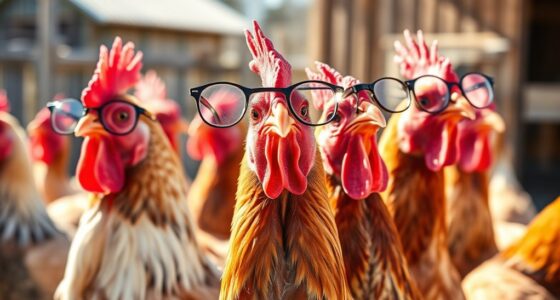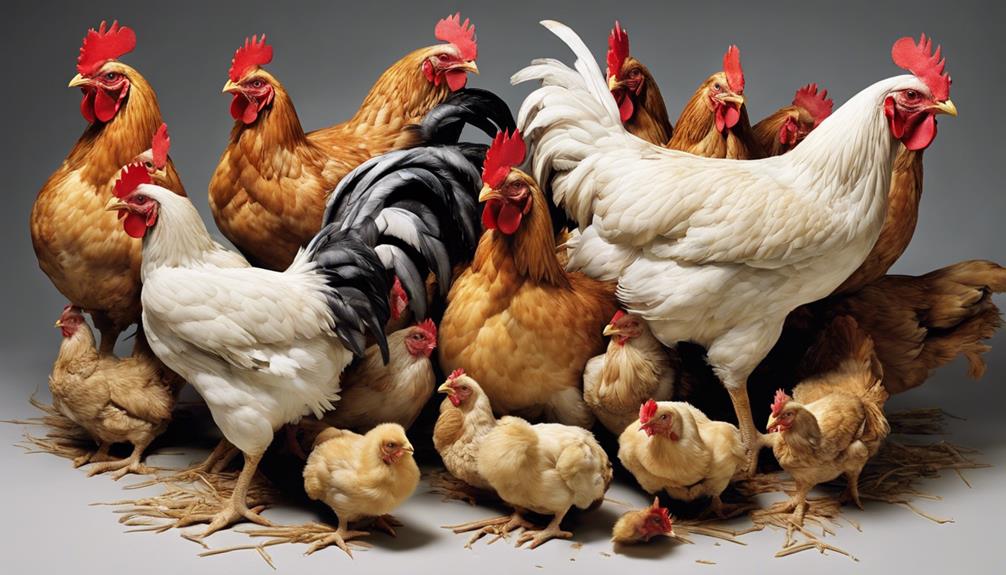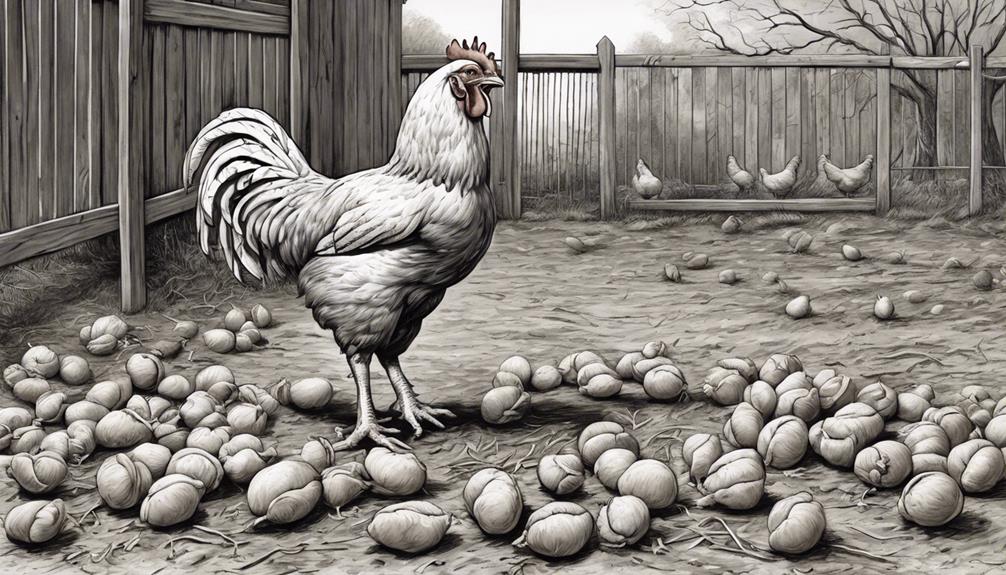Chickens that lay rainbow eggs do so because of specific genetic traits that influence both their feather colors and eggshell pigmentation. Certain breeds carry genes for vibrant shell colors like blue, green, or pink, thanks to pigments such as biliverdin and protoporphyrin. These genes are naturally present or enhanced through selective breeding, creating the colorful eggs you see. If you’re curious about how these genetics work together, there’s more to uncover about the fascinating science behind rainbow eggs.
Key Takeaways
- Rainbow eggs result from specific genetic traits influencing shell pigment deposition, like biliverdin and protoporphyrin.
- Breeds such as Easter Egger and Ameraucana carry genes that produce blue, green, or pink eggs.
- Egg shell color depends on pigment amount deposited during formation in the hen’s oviduct.
- Feather and shell colors are linked through genes that regulate pigmentation in chickens.
- Selective breeding enhances these genetic traits, increasing the variety of colorful eggs.

Have you ever wondered if chickens could lay eggs in every color of the rainbow? It’s a fascinating idea, and the truth is, some chickens do produce eggs with vibrant hues that go beyond the usual white and brown. This colorful display is largely influenced by the chickens’ genetics, specifically factors like colorful feathers and egg shell pigmentation. When you understand how these elements work together, it becomes clear how such a wide spectrum of egg colors is possible.
Chickens with colorful feathers often carry specific genes that influence their overall pigmentation. These genes are responsible for the bright reds, deep blacks, and iridescent greens you see in their plumage. But these same genetic traits can also affect the pigmentation of their eggshells. Certain breeds, such as the Easter Egger or the Ameraucana, have a genetic makeup that allows them to produce eggs in shades like blue, green, or even pink. This isn’t random; it’s a direct result of how their genes regulate the production of pigments in the eggshell.
Colorful feathers indicate genes that influence both plumage and eggshell pigmentation, producing vibrant rainbow eggs.
Egg shell pigmentation is determined by the presence of different pigments deposited during egg formation. For example, the blue or green hues come from a pigment called biliverdin, which is deposited on the eggshell during its formation in the oviduct. The intensity of the color depends on the amount of pigment produced and how it’s deposited, making some eggs more vividly colored than others. Meanwhile, the classic white eggshells lack significant pigment deposition, and brown eggs get their shade from protoporphyrin, which is another pigment produced by the hen.
The genetic control over these pigments is quite complex, involving multiple genes that determine whether a hen will lay a white, brown, blue, or green egg. When you combine this with the natural variation in these genes among individual chickens, it’s easy to see how a flock can produce a stunning array of colorful eggs. Some breeds have been selectively bred specifically for their unique shell colors, making them popular among backyard chicken keepers and farmers alike.
In short, the vibrant hues of rainbow eggs come down to a combination of genetics—particularly the genes that influence colorful feathers and egg shell pigmentation. Understanding genetic factors helps explain how these beautiful eggs are produced. When these genetic factors align, they create the beautiful, multicolored eggs that make your breakfast more vibrant and fun. So, next time you see an unusually colored egg, you’ll know it’s a tiny miracle of nature’s genetics at play.
Frequently Asked Questions
Can Rainbow Eggs Be Produced Through Selective Breeding?
You might wonder if rainbow eggs can be produced through selective breeding. While traditional breeding techniques focus on inheriting specific traits, creating vibrant, rainbow-colored eggs likely requires genetic modification. Selective breeding alone may not achieve such dramatic color variations, as it relies on existing genetic diversity. Genetic modification allows precise control over egg shell pigmentation, making rainbow eggs possible by directly altering the genes responsible for shell coloration.
Do Rainbow Eggs Have Any Nutritional Differences?
Rainbow eggs don’t have significant nutritional differences from regular eggs. Their nutritional content remains mostly the same, providing protein, vitamins, and minerals. However, some believe mineral differences, like higher levels of certain antioxidants, could be present due to the unique pigmentation process. But overall, the vibrant shell colors are mainly a result of genetics and pigment deposition, not affecting the eggs’ nutritional value.
Are Rainbow Eggs Safe to Eat?
You might think rainbow eggs are a magical treat, but don’t worry—egg dyeing and natural genetics don’t make them unsafe. These eggs are just as safe as regular ones because egg contamination isn’t caused by their colors. The vibrant hues come from safe, natural pigments or dyes, so you can enjoy rainbow eggs without fear. They’re a fun, colorful way to add excitement to your breakfast, with no health risks involved.
How Rare Are Chickens That Lay Rainbow Eggs?
You might wonder how rare chickens that lay rainbow eggs are. These chickens are quite uncommon because they result from rare genetic mutations causing unusual pigmentation in eggshells. While some breeds are known for their vibrant eggs, truly rainbow-colored eggs are a rare find. If you’re lucky enough to find one, it’s likely due to unique genetic factors, making these chickens a fascinating and rare occurrence in the poultry world.
Can Environmental Factors Influence Egg Color?
Did you know that environmental factors can actually influence egg color? You might think genetics are the only factor, but diet and environment also play a role. Feather pigmentation, for example, can be affected by what chickens eat and their surroundings. Changes in feed or stress levels can cause subtle shifts in shell hue. So, if you want vibrant eggs, maintaining a balanced diet and a calm environment is essential.
Conclusion
Now, just like Pandora’s box revealing unexpected wonders, these rainbow eggs remind you that nature’s palette is full of surprises. With a little understanding of genetics, you see the magic behind the colors—unique combinations, just like a painter’s brush strokes. So, next time you spot a rainbow egg, remember you’re witnessing a tiny miracle, a modern-day fairy tale spun from DNA’s intricate threads—proof that nature’s most vibrant stories are written in the code of life.










